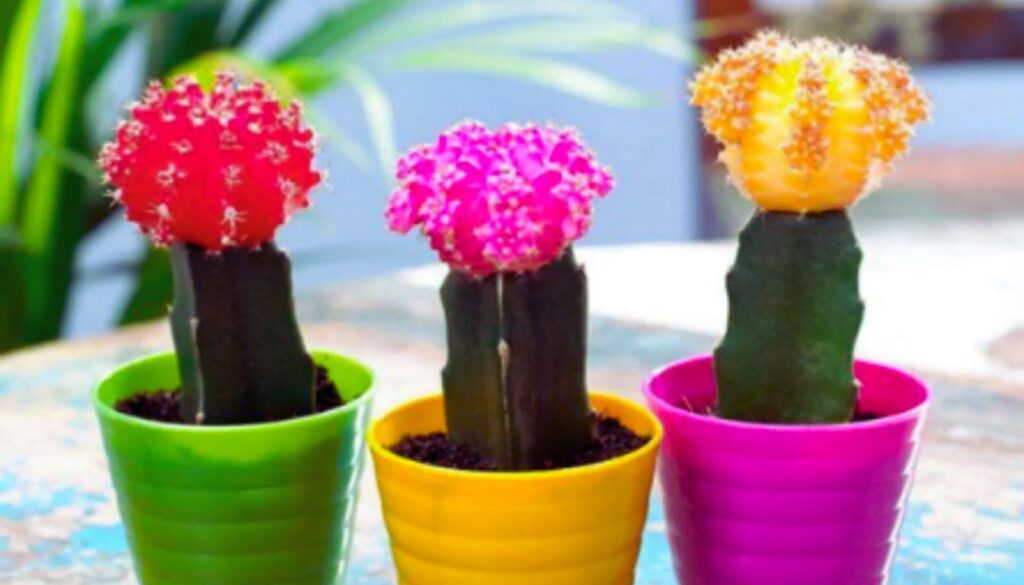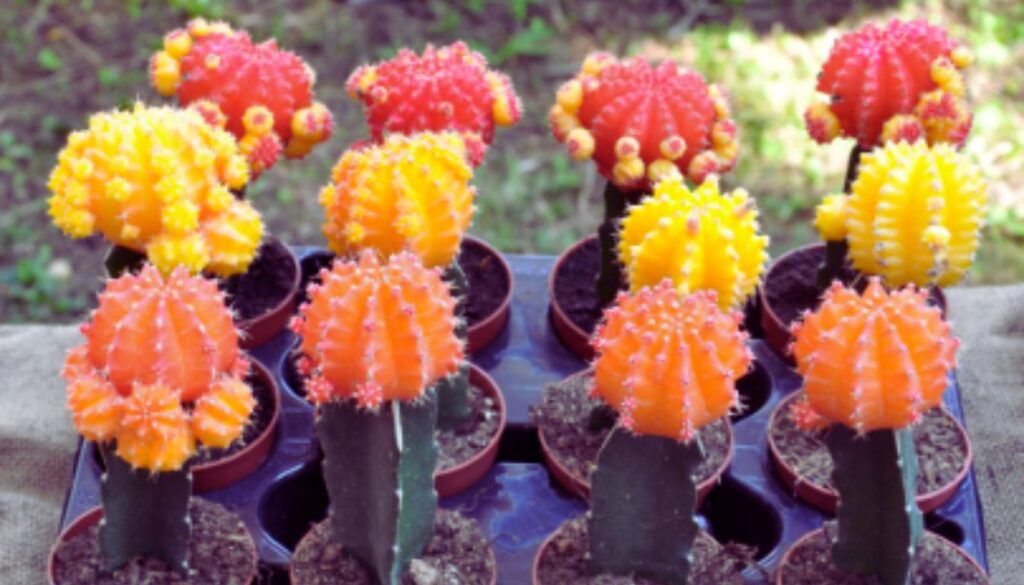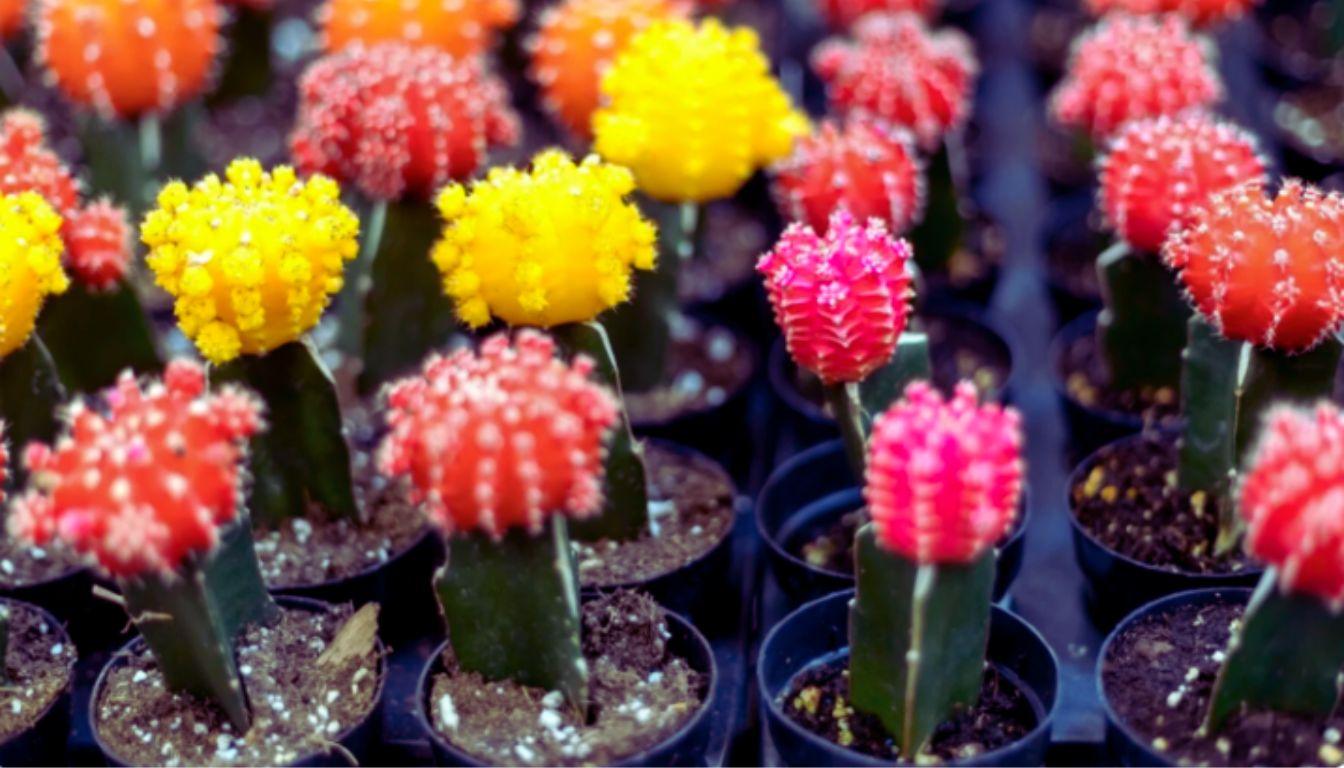If you’re looking to add a pop of color to your home or garden, moon cactus plants are the perfect choice. These vibrant, eye-catching succulents are not just beautiful; they’re also incredibly easy to care for. With their unique, colorful tops and sturdy bases, they make a stunning addition to any space, whether you’re a seasoned gardener or just starting out.
Overview of Moon Cactus
Moon cactus plants stand out for their bright colors and unique appearance. These cacti consist of a base cactus and a colorful top, often in shades of pink, red, or yellow. Their vibrant hues catch the eye and add a pop of color to any space.
Growing moon cacti is simple. They thrive in well-draining soil and prefer bright, indirect light. Water them sparingly, allowing the soil to dry out between waterings. Overwatering usually leads to root rot, which is a cactus’s worst nightmare.
Moon cacti also respond well to periodic feeding. A diluted liquid cactus fertilizer once a month during the growing season provides essential nutrients. My moon cactus loves this little boost, and it shows in its growth!
These plants often grow to about 12 inches tall, making them suitable for small pots or shelves. They also adapt well to indoor settings. Their low care requirements make them perfect for busy individuals like me who still want a vibrant plant around.
Pests can occasionally cause issues, but regular checks can prevent infestations. A soap-water mix usually handles most pests effectively. If you see any fuzzy little intruders, don’t panic, just take action!
Overall, moon cactus plants bring brightness and joy. Their easy care routine and fun colors make them a wonderful addition to my plant collection.
Selecting the Right Moon Cactus – How to Plant and Grow Moon Cactus Plants

Selecting the perfect moon cactus can brighten your collection. Understanding the different varieties and key factors aids in making the right choice.
Varieties of Moon Cactus
Moon cactus comes in several varieties, each displaying its unique flair. The most popular types include:
- Gymnocalycium mihanovichii: This variety features vibrant tops in colors like pink, red, and yellow. The bright hues stand out beautifully.
- Moon Cactus with Gimnocalycium: This option shows various combinations, often pairing a colorful top with a green base, adding more character.
- Fertilized Moon Cactus: Sometimes sold with different colored tops, these plants exhibit incredible charm. They may have already been grafted onto green cactus bases.
Choosing a variety adds personal flair to your plant collection. Each one brings a pop of color to your space.
Factors to Consider When Choosing
Consider a few important factors when selecting your moon cactus.
- Color: Bright colors attract attention. Select a top color that fits your style or decor.
- Size: Moon cacti can range in size. Think about where you want to place it. Smaller cacti fit well on desks, while larger ones suit bigger spaces.
- Health: Inspect the plant for signs of rot or pests. Healthy plants show no discoloration and have firm tops.
- Base Stability: Look for a cactus with a sturdy base. A solid foundation helps the plant thrive.
Preparing to Plant – How to Plant and Grow Moon Cactus Plants
Knowing how to prepare for planting moon cactus plants makes the process easier and more enjoyable. Let’s dive into the essentials.
Necessary Tools and Materials
Gathering the right tools and materials ensures a smooth planting experience. Start with a small pot that has drainage holes. This strategy prevents water buildup, keeping roots healthy. I prefer using gloves to protect my hands when handling soil and cacti. A trowel simplifies transferring soil into pots, while a watering can helps with gentle watering. Keep some cactus fertilizer handy for future feedings. Finally, grab some stones or gravel. This layer at the bottom of the pot improves drainage.
Selecting the Best Potting Mix
Choosing the right potting mix is crucial for moon cactus success. Cacti thrive in well-draining soil. Look for a potting mix specifically designed for cacti or succulents. If I can’t find that, I mix regular potting soil with sand and perlite. This combo boosts drainage and airflow around the roots. Always aim for a light and airy texture. When I plant, I fill the pot about three-quarters full of mix, leaving room for the cactus. A good potting mix contributes to the vibrant health of my moon cacti.
Planting Your Moon Cactus – How to Plant and Grow Moon Cactus Plants

Planting a moon cactus can be both fun and rewarding. Follow these steps to ensure your cactus thrives in its new home.
Step-by-Step Planting Process
- Select a Pot. Choose a small pot with drainage holes. This helps prevent excess water buildup, which can lead to root rot.
- Prepare the Soil. Mix cactus potting soil with sand and perlite for better drainage. It should feel gritty to the touch.
- Add Gravel. Place a layer of stones or gravel at the bottom of the pot. This improves drainage even more.
- Plant the Cactus. Remove your moon cactus from its original pot. Place it gently into the new pot. Make sure the grafted top sits above the soil line.
- Fill with Soil. Add the soil mixture around the cactus. Press it down lightly to secure it in place.
- Water Sparingly. Water the cactus lightly after planting. Focus on keeping the soil just moist, not soggy.
- Position the Pot. Set the pot in a location with bright, indirect light. Moon cacti bask in light but avoid direct sun.
- Check for Pests. Examine the cactus for pests before planting. Even the tiniest bugs can spoil your planting adventure.
- Avoid Overwatering. Water only when the top inch of soil feels dry. Cacti prefer to be on the dry side like I prefer my weekends.
- Feed Smart. Use diluted cactus fertilizer during the growing season. Just a little bit can go a long way.
- Enjoy the Process. Take your time while planting. Enjoy the vibrant colors and unique shapes that make moon cacti so special.
Caring for Your Moon Cactus – How to Plant and Grow Moon Cactus Plants
Caring for your moon cactus keeps it vibrant and healthy. Understanding its needs makes the process simple and enjoyable.
Watering Guidelines
Watering moon cacti requires a light touch. I check the soil before watering. If the top inch feels dry, it’s time to give it a drink. Use room temperature water to avoid shocking the plant. Overwatering poses a risk of root rot, so I always err on the side of less water. Just like me, moon cacti prefer to be a bit thirsty!
Light and Temperature Requirements
Moon cacti love bright, indirect light. I find the best spot for mine is near a window that offers filtered light. Direct sunlight can scorch their colorful tops. Temperature matters too. These plants thrive in temperatures between 70°F and 100°F. They can tolerate cooler temperatures for short periods but might not be too happy about it. Keep them warm, and they’ll keep shining!
Common Issues and Solutions – How to Plant and Grow Moon Cactus Plants
Moon cactus plants, while low-maintenance, can encounter some challenges. Addressing these issues quickly keeps these colorful gems thriving in your home.
Pests and Diseases
Tiny pests can invade moon cacti. Mealybugs and spider mites are common culprits. I spot them on the plant’s surface or near the soil. Treating them is simple; I mix mild soap with water and gently spray the affected areas. Spraying this solution once a week usually keeps these critters at bay. Fungal diseases can occur, especially if the cactus is overwatered. If I notice any black spots on the cactus, I remove the affected areas promptly. Maintaining proper watering habits helps prevent these diseases.
Signs of Poor Health
Recognizing problems early is crucial for moon cacti. If I see the cactus becoming soft, it often signals overwatering. Roots might be rotting underneath the soil. A healthy cactus should feel firm to the touch. Discoloration can also indicate stress. Yellowing tops often mean it’s getting too much sunlight. If my moon cactus starts to look lean or elongated, it might not be receiving enough light. Adjusting its position for better light usually brings the vibrancy back. In any case, acting quickly helps my cactus stay healthy and colorful.
Before You Go – How to Plant and Grow Moon Cactus Plants
Planting and growing moon cactus plants is a rewarding experience that brings vibrant colors into my space. With their unique appearance and low-maintenance care requirements, these cacti are perfect for anyone looking to brighten their home or garden.
By following the tips on planting and caring for them, I can ensure my moon cacti thrive and stay healthy. Regular checks for pests and proper watering practices are key to maintaining their beauty.
Whether I’m a seasoned gardener or just starting out, moon cacti offer a delightful addition to my plant collection, effortlessly adding a splash of color and joy to my surroundings. Don’t forget to add The Herb Prof to your favorites so you don’t miss out on future articles.
References – How to Plant and Grow Moon Cactus Plants
Little Herb Encyclopedia, by Jack Ritchason; N.D., Woodland Publishing Incorporated, 1995
The Ultimate Healing System, Course Manual, Copyright 1985, Don Lepore
Planetary Herbology, Michael Tierra, C.A., N.D., Lotus Press, 1988
Handbook of Medicinal Herbs, by James A. Duke, Pub. CRP Second Edition 2007
The Complete Medicinal Herbal, by Penelope Ody, Published by Dorling Kindersley
Check the Following Articles
Best Potato Starch Alternatives for Cooking and Baking
Unlocking the Benefits of Bitter Gourd Juice
Using Wine Corks as Mulch For Your Garden
Making Seed Tapes Using Toilet Paper Rolls
Frequently Asked Questions – How to Plant and Grow Moon Cactus Plants
What are moon cactus plants?
Moon cactus plants are colorful cacti known for their vibrant tops in shades of pink, red, or yellow, growing on a sturdy green base. They are ideal for home or garden settings, being both visually appealing and easy to care for.
How do you care for moon cactus plants?
Moon cacti require bright, indirect light and well-draining soil. Water them sparingly to avoid root rot and feed with a diluted cactus fertilizer during the growing season for optimal growth.
What soil is best for moon cactus planting?
A well-draining soil mix specifically designed for cacti is best. You can also create a mix using regular potting soil combined with sand and perlite to ensure good drainage.
How often should I water my moon cactus?
Water your moon cactus sparingly, allowing the soil to dry out completely between watering. Checking the soil moisture helps prevent overwatering, which can lead to root rot.
What pests should I watch for on moon cacti?
Common pests include mealybugs and spider mites. Regularly inspect your moon cacti and treat infestations with a mild soap-water solution to keep them healthy and vibrant.
How should I choose the right moon cactus?
Select a moon cactus based on color, size, health, and base stability. Popular varieties include Gymnocalycium mihanovichii. Ensure the cactus complements your space for the best aesthetic impact.
Can I keep moon cacti indoors?
Yes! Moon cacti thrive indoors, especially in bright, indirect light. Their compact size makes them perfect for small pots and low-maintenance environments, making them suitable for busy individuals.
What temperatures do moon cacti prefer?
Moon cacti prefer temperatures between 70°F and 100°F. They thrive in warm conditions but should be protected from direct sunlight and cold drafts to remain healthy.

